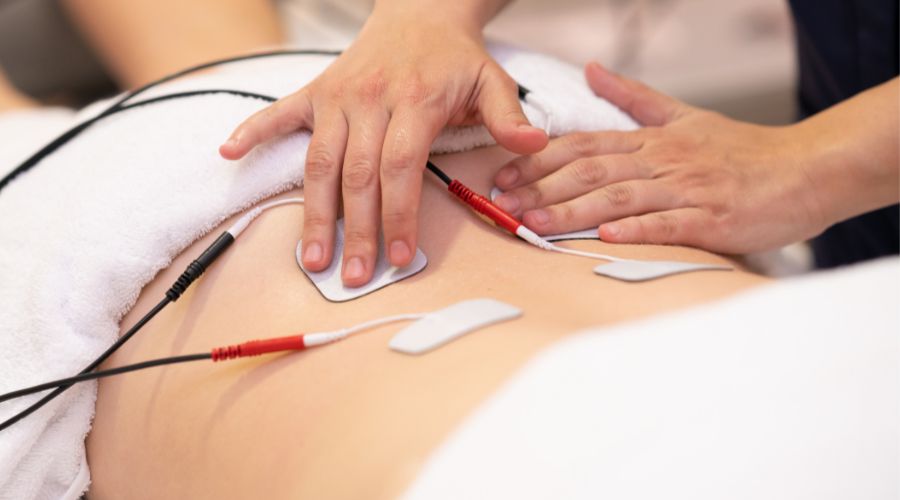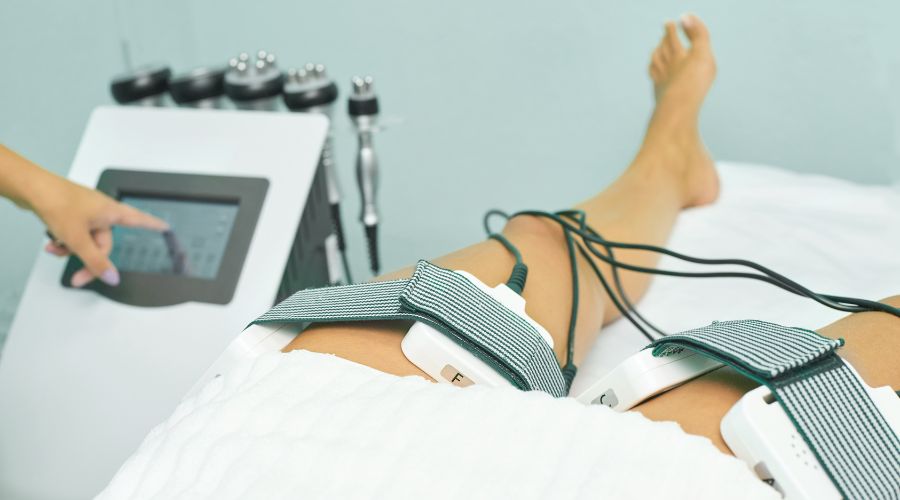In the dynamic field of fitness and rehabilitation, new tools and methods are continually being developed to support people in achieving their wellness and health objectives. Electric muscle stimulation (EMS) is one such advancement that has attracted a lot of interest. EMS presents a promising method for boosting muscle strength, promoting recuperation, and enhancing athletic performance by using electrical impulses to trigger muscle contractions. You’ve come to the perfect place if you want to find out more about this cutting-edge technique.
This comprehensive guide will explore everything you need to know about Electric Muscle Stimulation (EMS). Whether you’re an athlete looking to gain a competitive edge or someone seeking effective rehabilitation techniques, this blog will provide valuable insights into the world of EMS and its potential to transform your fitness journey. So, let’s dive in and unravel the mysteries of Electric Muscle Stimulation!
1. What is Electric Muscle Stimulation (EMS) And How Does It Work?

Electrical impulses are used in the Electric Muscular Stimulation (EMS) technique to encourage muscular contractions. Through electrodes positioned on the skin, EMS devices are used to transmit these impulses to the desired muscles. EMS stimulates the motor nerves, which in turn causes the muscles to contract and relax by imitating the signals of the central nervous system.
With EMS’s adjustable settings, users may target particular muscle areas and meet a variety of training objectives by using varied frequencies, intensities, and pulse durations. Compared to voluntary contractions, EMS can activate a greater proportion of muscle fibers, improving muscle strength, endurance, and performance as a whole.
EMS can be used as an additional training technique to improve muscle activation, offer training variety, and support injury healing and rehabilitation, even if it is not a replacement for conventional exercise. Individuals that use EMS in their workout routines can maximize muscle stimulation and possibly improve their training and performance.
2. Differentiating Between EMS And Other Muscle Stimulation Methods

When exploring muscle stimulation methods, it’s important to differentiate Electric Muscle Stimulation (EMS) from other techniques. Here are the key distinctions:
EMS vs. TENS:
There are two different ways to stimulate muscles: EMS (Electric Muscle Stimulation) and TENS (Transcutaneous Electrical Nerve Stimulation). Both target various parts of the body with electrical impulses, but they do it in distinct ways. TENS primarily aims to stimulate nerves to relieve pain. For treating disorders involving persistent pain, it is frequently utilized. Contrarily, EMS targets specific muscle groups to trigger contractions and enhance muscle performance. EMS is frequently utilized in muscle recovery, rehabilitation, and fitness training programs.
EMS vs. NMES:
Muscle rehabilitation and re-education frequently involve the use of Neuromuscular Electrical Stimulation (NMES), a subset of EMS. NMES uses electrical impulses to activate specific muscles and enhance their performance. It is frequently applied in physical therapy settings to help muscles heal after accidents or operations. Although EMS and NMES are closely linked and have comparable methods for inducing muscle contractions, NMES focuses particularly on the neuromuscular system and is designed for therapeutic purposes.
EMS vs. Voluntary Exercise:
Although EMS can be a useful complement to a fitness routine, it should not be used as a substitute for active exercise. A person must actively participate in the voluntary exercise, which calls for coordination, cardiovascular fitness, and the use of numerous muscle groups. For overall health and fitness, it offers a wide range of advantages. Contrarily, EMS stimulates specific muscles and can be used in addition to voluntary exercise. It can not duplicate the complete spectrum of advantages that come from engaging in voluntary exercise, but it can help improve muscle activation, offer more resistance, or speed up the healing process.
EMS vs. Passive Exercise:
Exercise that is performed passively involves the use of equipment or forces from outside the body to move the entire body or certain body sections. The use of limb-moving equipment or massage therapy is two examples of passive exercise. While EMS does not demand active participation from the patient, EMS uses active muscular contractions as a result of electrical impulses. Between EMS and passive exercise, this active engagement is a crucial contrast. Passive exercise depends on external forces or technologies to create movement without active muscle engagement, whereas EMS induces muscle contractions by electrical impulses, increasing muscle activation and strength growth.
3. Benefits Of Electric Muscle Stimulation

Electric Muscle Stimulation (EMS) offers a range of benefits for individuals seeking to improve their fitness, enhance performance, or aid in rehabilitation. Some benefits of EMS are mentioned below:
- Muscle Strength and Endurance: Muscle strength and endurance can be significantly increased using EMS. EMS can result in significant strength improvements because it activates a greater proportion of muscle fibers than voluntary contractions do. Due to the muscles’ increased capacity to withstand sustained effort, the deep muscular contractions caused by EMS also aid in boosting endurance. For athletes trying to improve their performance in endurance sports or for anyone looking to concurrently develop strength and endurance, this can be especially helpful.
- Efficient Workouts: Being able to give efficient workouts is one of EMS’s significant advantages. EMS allows for the simultaneous targeting of different muscle groups, resulting in more thorough training sessions. Comparative to typical training approaches, this implies that you can activate and excite more muscles in less time. For those who have little time for training or who want to make the most of their workout regimens, this efficiency is extremely beneficial.
- Muscle Recovery and Rehabilitation: The recovery and rehabilitation of muscles benefit greatly from EMS. In order to promote nutrient supply and waste disposal as well as blood flow to the targeted muscles, EMS devices emit electrical impulses that can speed up the healing process. EMS can also help with muscle re-education and activation following recovery from an injury or surgery. EMS increases neuromuscular control, prevents muscle atrophy, and maintains muscle mass by promoting muscle contractions.
- Injury Prevention: The ability of EMS to prevent injuries is another advantage. EMS can lessen the chance of injuries by treating muscle imbalances and improving muscular strength. Injury risk might be increased during physical activity by imbalances between agonist and antagonist muscles or by weak stabilizing muscles. The likelihood of injuries can be decreased by using EMS to target these particular muscle groups, which encourages balanced muscle development and improves joint stability.
- Enhanced Performance: In numerous sports and activities, EMS has been found to enhance athletic performance. Athletes can enhance their training and performance with the use of EMS, which enhances muscle strength, power, and coordination. It is possible to train for a specific sport or activity and increase performance overall by being able to target the muscle groups employed in that activity or sport. To boost muscle adaptations and enhance performance outcomes, EMS can be utilized in addition to conventional training methods.
- Convenience and Accessibility: Because EMS is convenient and accessible, it may be used by a wide range of people. EMS equipment is small, portable, and user-friendly, making it simple to use at home or while traveling. Due to its accessibility, it might be a good training alternative for people who might not have access to conventional gyms or who would rather exercise in the comfort of their own homes. Additionally, EMS offers a low-impact training method that may be customized to meet the needs of people with physical disabilities or those going through rehabilitation.
4. Safety Considerations For Electric Muscle Stimulation

While Electric Muscle Stimulation (EMS) can offer various benefits, it is essential to consider safety precautions when using EMS devices. Some key safety considerations to keep in mind are mentioned below:
Quality and Approved Devices: Make sure you are utilizing an excellent EMS device that has received regulatory approval. In order to ensure that a product meets safety requirements, look for certifications or endorsements from trustworthy organizations.
Proper Application and Placement: When applying and placing electrodes, follow the manufacturer’s instructions. Inconvenience, skin rashes, or inadequate muscle stimulation may result from improper placement or application. Inspect the electrodes to make sure they are positioned properly and are held firmly against the skin.
Gradual Intensity Progression: Begin slowly and increase your intensity as you become more at ease. A sudden increase in intensity can cause stress, pain, and even possible muscle damage. Keep within your comfort level and be aware of your body.
Avoid Sensitive Areas: Avoid placing electrodes close to delicate areas like the head, throat, or eyes. In these areas, the electrical impulses may be uncomfortable or have negative effects. Following the instructions for recommended electrode placement given by the device’s manufacturer is crucial.
Not for Everyone: EMS may not be suitable for everyone, including individuals with certain medical conditions such as epilepsy, heart problems, pacemakers, or implanted medical devices. Pregnant women should also consult with their healthcare provider before using EMS.
Sensations and Feedback: During EMS sessions, be aware of your feelings. Although minor muscle spasms and tingling sensations are common, if you feel extreme pain, burning, or discomfort, cease the session and seek expert help.
Use as a Supplement: EMS must not take the place of regular exercise or physical activity. It works best when utilized as a supplemental workout technique in conjunction with a comprehensive fitness regimen.
5. Consulting With A Healthcare Professional Or Certified Trainer Before Starting An EMS Program

For a variety of reasons, it is strongly advised that you consult with a healthcare professional or certified EMS fitness trainer before starting an EMS program. They can determine which EMS is best for your particular situation, assess your individual needs, and offer advice on how to use it properly. These specialists can offer personalized recommendations and create an EMS program that is specific to your objectives because they are knowledgeable about correct EMS procedures and safety considerations. Additionally, they have the knowledge and experience to integrate EMS into your total fitness program and track your progress and make adjustments as necessary. Working with experts will help you reduce risks, maximize EMS’s advantages, and guarantee your safety at all times.
6. Factors To Consider When Choosing The Right EMS Device

When selecting an Electric Muscle Stimulation (EMS) device, there are several important factors to consider. Here are some key considerations to help you choose the right EMS device for your needs:
Quality and Safety: Make sure the EMS device you select is of high quality and complies with safety requirements. Look for gadgets that have regulatory authority approval or certification from reliable bodies. This guarantees that the apparatus has undergone testing and complies with safety regulations.
Program Customization: Select an EMS device that offers a number of customizable settings and programs. As a result, you can modify the electrical impulses’ strength, frequency, and length to fit your tastes and objectives. The efficacy and comfort of your training can be improved by having the freedom to customize the EMS sessions to your particular demands.
Ease of Use: Think about the EMS device’s ease of use. Look for gadgets with easy-to-follow directions, simple controls, and simple electrode installation. Your EMS sessions will be more convenient and hassle-free with a simple-to-use device.
Electrode Quality and Longevity: Aspect the electrodes that come with the EMS instrument carefully for quality. In addition to offering the best electrical conductivity, high-quality electrodes should be strong and durable. Check to see if replacement electrodes are cost-effective and easily accessible.
Portability and Convenience: Think about the EMS device’s portability and convenience. A portable, lightweight device can be better if you intend to use it at home or while traveling. Look for gadgets that have a carrying case or are constructed to be portable.
Brand Reputation and Reviews: Before making a purchase, check the brand’s reputation and read user reviews. Check reviews for information about the product’s efficiency, robustness, and customer service. The performance and dependability of the EMS device may be better understood with the use of this information.
Price and Value: The price of various EMS devices should be compared. Evaluate each device’s features, build, and overall value. Though finding a cost-effective solution is crucial, quality and safety should always come first.
Conclusion
A variety of advantages are provided by Electric Muscle Stimulation (EMS), including increased muscle strength and endurance as well as assistance with recovery and rehabilitation. Although the results of this ground-breaking technology have been encouraging, it is crucia to comprehend its fundamentals, efficacy, and safety issues before implementing it into your exercise or rehabilitation regimen. Like with any new exercise or training regimen, it’s critical to get advice from experts and adhere to the correct procedures. You may use electric muscle stimulation to help you reach your wellness and fitness objectives if you have the correct information and strategy.
Recommended:

